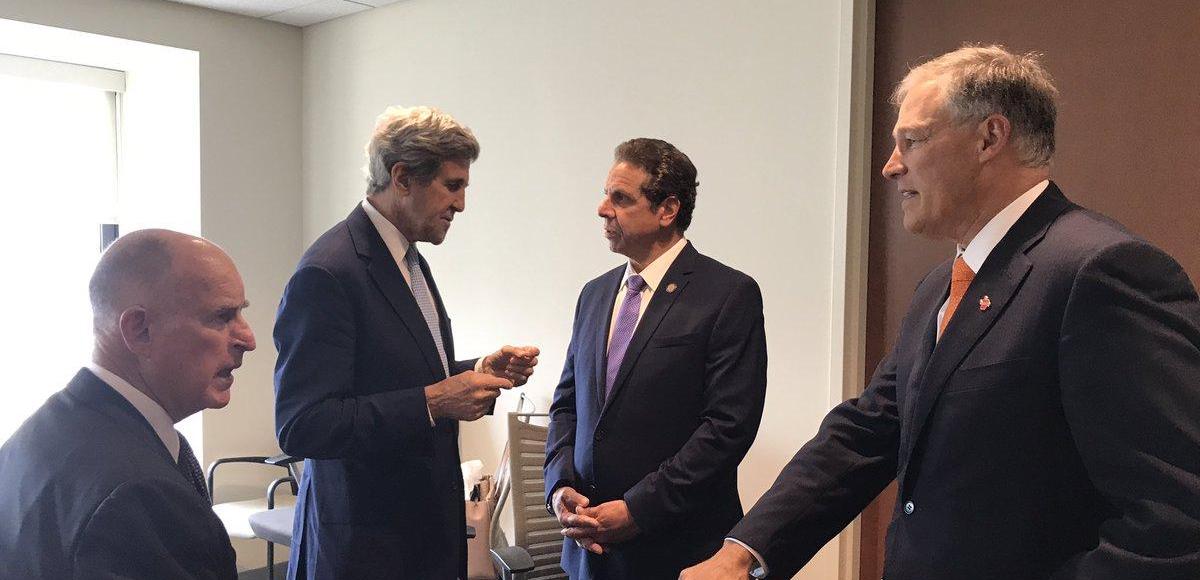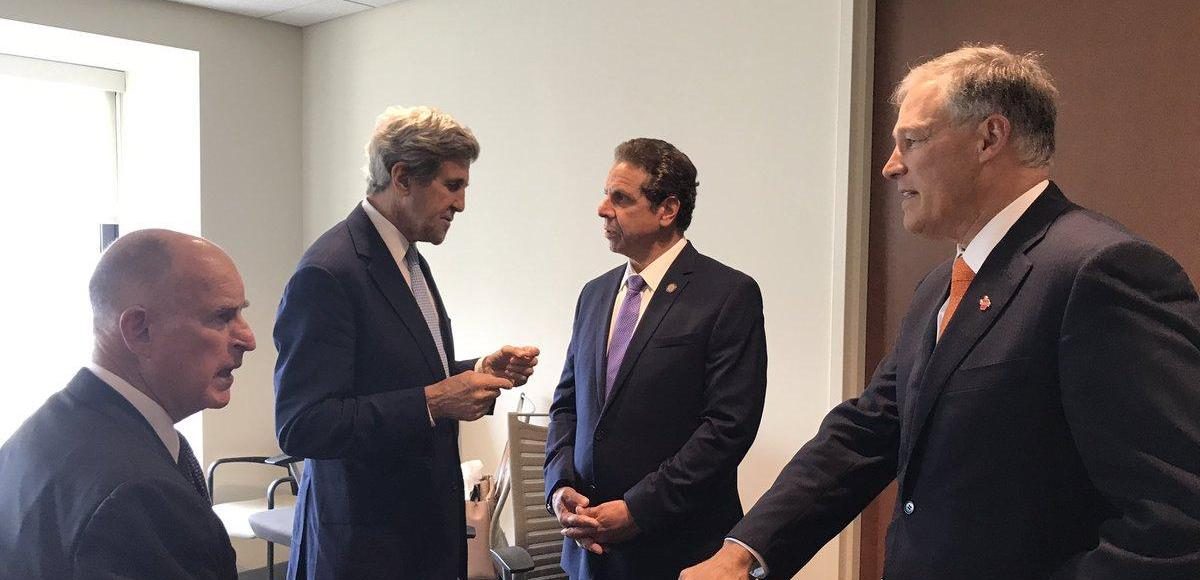
From left to right: Governor Jerry Brown, D-Calif., John Kerry, D-Mass., Governor Andrew Cuomo, D-N.Y., and Governor Jay Inslee, D-Wa., meet in Governor Cuomo’s office in New York City. (Photo: Courtesy of the New York Governor’s Office)
California is a lot like France. They’re both wonderful places to visit and they’re both great places to live if you already have a lot of money.
But neither jurisdiction is very friendly to people who want to get rich. And, thanks to tax competition, that’s having a meaningful impact on migration patterns.
I’ve previously written about the exodus of successful and/or aspirational people from France.
Today we’re going to examine the same process inside the United States.
It’s a process that is about to get more intense thanks to federal tax reform, as Art Laffer and Steve Moore explain in a column for the Wall Street Journal.
In the years to come, millions of people, thousands of businesses, and tens of billions of dollars of net income will flee high-tax blue states for low-tax red states. This migration has been happening for years. But the Trump tax bill’s cap on the deduction for state and local taxes, or SALT, will accelerate the pace. …Consider what this means if you’re a high-income earner in Silicon Valley or Hollywood. The top tax rate that you actually pay just jumped from about 8.5% to 13%. Similar figures hold if you live in Manhattan, once New York City’s income tax is factored in. If you earn $10 million or more, your taxes might increase a whopping 50%. …high earners in places with hefty income taxes—not just California and New York, but also Minnesota and New Jersey—will bear more of the true cost of their state government. Also in big trouble are Connecticut and Illinois, where the overall state and local tax burden (especially property taxes) is so onerous that high-income residents will feel the burn now that they can’t deduct these costs on their federal returns. On the other side are nine states—including Florida, Nevada, Texas and Washington—that impose no tax at all on earned income.
Art and Steve put together projections on what this will mean.
Over the past decade, about 3.5 million Americans on net have relocated from the highest-tax states to the lowest-tax ones. …Our analysis of IRS data on tax returns shows that in the past three years alone, Texas and Florida have gained a net $50 billion in income and purchasing power from other states, while California and New York have surrendered a net $23 billion. Now that the SALT subsidy is gone, how bad will it get for high-tax blue states? Very bad. We estimate, based on the historical relationship between tax rates and migration patterns, that both California and New York will lose on net about 800,000 residents over the next three years—roughly twice the number that left from 2014-16. Our calculations suggest that Connecticut, New Jersey and Minnesota combined will hemorrhage another roughly 500,000 people in the same period. …the exodus could puncture large and unexpected holes in blue-state budgets. Lawmakers in Hartford and Trenton have gotten a small taste of this in recent years as billionaire financiers have flown the coop and relocated to Florida. …Progressives should do the math: A 13% tax rate generates zero revenue from someone who leaves the state for friendlier climes.
I don’t know if their estimate is too high or too low, but there’s no question that they are correct about the direction of migration.
And every time a net taxpayer moves out, that further erodes the fiscal position of the high-tax states. Which is why I think one of the interesting questions is which state will be the first to suffer fiscal collapse.
In large part, taxpayers are making a rational cost-benefit analysis. Some states have dramatically increased the burden of government spending. Yet does anyone think that those states are providing better services than states with smaller public sectors? Or that those services are worth all the taxes they have to pay?
Consider, for instance, the difference between New York and Tennessee.
New York spends nearly twice as much on state and local government per person ($16,000) as does economically booming Tennessee ($9,000).
Anyhow, I’m guessing the new restriction on the state and local tax deduction is going to change the behavior of state politicians. At least I hope so.
But nobody ever said politicians were sensible. Ross Marchand of the Taxpayers Protection Alliance explains that Massachusetts and New Jersey are still thinking about more class-warfare taxation.
Massachusetts and New Jersey are currently considering “millionaires’ taxes,” which would significantly increase top rates and spark a “race to the top” for revenue… Instead of helping out the middle class, a millionaires’ tax will result in an exodus from the state, squeezing out opportunities for working Americans. …Prominent millionaires respond to these proposals by threatening to leave, and research shows that the well-to-do regularly follow through on these promises. …nearly all of the migration that does happen in top brackets has to do with tax changes. Researchers at Stanford University and the Treasury Department estimate that a 10 percent increase in taxes causes a 1 percent bump in migration, assuming no change in any other policy. …If New Jersey and Massachusetts approve new millionaires’ taxes, it is difficult to predict how much will be raised and where these funds will ultimately wind up. But if New York and California are any guide, income surtaxes will be destructive. When it comes to higher taxation, interstate migration is just the tip of the iceberg. Higher-tax states, for instance, see less innovative activity and scientific research according to an analysis by economists at the Federal Reserve and UC Berkeley.
My suggestion is that politicians in Massachusetts and New Jersey should look at what’s happening to California.
CNBC reports on the growing exodus from the Golden State.
Californians may still love the beautiful weather and beaches, but more and more they are fed up with the high housing costs and taxes and deciding to flee to lower-cost states such as Nevada, Arizona and Texas. …said Dave Senser, who lives on a fixed income near San Luis Obispo, California, and now plans to move to Las Vegas. “Rents here are crazy, if you can find a place, and they’re going to tax us to death. That’s what it feels like. At least in Nevada they don’t have a state income tax. And every little bit helps.” …Data from United Van Lines show some of the most popular moving destinations for Californians from 2015 to 2017 were Texas, Arizona, Oregon, Washington and Colorado. Other experts also said Nevada remains a top destination. …Internal Revenue Service data would appear to show that the middle-class and middle-age residents are the ones leaving, according to Joel Kotkin, a presidential fellow in Urban Futures at Chapman University in Orange, California. …Furthermore, Kotkin believes the outmigration from California may start to rise among higher-income people, given that the GOP’s federal tax overhaul will result in certain California taxpayers losing from the state and local tax deduction cap.
The Legislative Analyst’s Office for the California legislature has warned the state’s lawmakers about this trend.
For many years, more people have been leaving California for other states than have been moving here. According to data from the American Community Survey, from 2007 to 2016, about 5 million people moved to California from other states, while about 6 million left California. On net, the state lost 1 million residents to domestic migration—about 2.5 percent of its total population. …Although California generally has been losing residents to the rest of the country, movement between California and some states deviates from this pattern. The figure below shows net migration between California and individual states between 2007 and 2016. California gained, on net, residents from about one-third of states, led by New York, Illinois, and New Jersey.
Here’s the chart showing where Californians are moving. Unsurprisingly, Texas is the main destination.

By the way, state-to-state migration isn’t solely a function of income taxes.
A Market Watch column looks at the impact of property taxes on migration patterns.
Harty’s clients range from first-time buyers with sticker shock to people who’ve lived in and around Chicago all their lives. Each has a different story, but they share a common theme: many believe that Chicago-area property taxes are too high, and relief is just an hour away over the state line. …if all real estate is local, all real estate taxes may be even more so. …Attom’s data show that the average tax burden ranges from $10,612 in the most expensive metro area, Bridgeport-Stamford-Norwalk, Connecticut, to $525 in Montgomery, Alabama. And those are just averages. …taxes are “the icing on the cake” in areas that are seeing strong population inflows… Among the counties that saw the biggest percentage of in-migration in 2017, according to Census data, all are in Texas, Florida, Georgia, or the Carolinas. (Texas doesn’t have particularly low property taxes, but it has no personal income tax, making the overall tax burden much more manageable.) Cook County, where Chicago is located, had the biggest number of people leaving… Blomquist’s analysis of Census data showed that among all counties that had at least a 1% population increase, the average tax bill was $2,706, while in all counties with a least a 1% decline in population, the average was $3,900.
The key sentence in that excerpt is the part about Texas having relatively high property taxes, but making up for that by having no state income tax.
The same thing is true about New Hampshire.
But just imagine what it must be like to live in a state with high income taxes and high property taxes. If this map is any indication, places such as New York and Illinois are particularly awful for taxpayers.

Let’s close with a big-picture look at factors that drive state competitiveness.
Mark Perry takes an up-close look at the characteristics of the five states with the most in-migration and out-migration.
…four of the top five outbound states (Illinois ranked No. 46, Connecticut at No. 49, New Jersey at No. 48, and California at No. 47) were among the five US states with the highest tax burden — New York was No. 50 (highest tax burden). The average tax burden of the top five outbound states was 11.2%, with an average rank of 43.2 out of 50. In contrast, the top five inbound states have an average tax burden of 8.7% and an average rank of 16.6 out of 50. As would be expected, Americans are leaving states with some of the country’s highest overall tax burdens (IL, CT, CA and NJ) and moving to states with lower tax burdens (TN, SC and AZ). …that there are significant differences between the top five inbound and top five outbound US states when they are compared on a variety of measures of economic performance, business climate, tax burdens for businesses and individuals, fiscal health, and labor market dynamism. There is empirical evidence that Americans do “vote with their feet” when they relocate from one state to another, and the evidence suggests that Americans are moving from states that are relatively more economically stagnant, Democratic-controlled fiscally unhealthy states with higher tax burdens, more regulations and with fewer economic and job opportunities to Republican-controlled, fiscally sound states that are relatively more economically vibrant, dynamic and business-friendly, with lower tax and regulatory burdens and more economic and job opportunities.
Here’s Mark’s table, based on 2017 migration data.

As Mark said, people do “vote with their feet” for smaller government.
Which is one of the reasons I’m a big fan of federalism. When there’s decentralization, people can escape bad policy. And that helps to discipline profligate governments.























